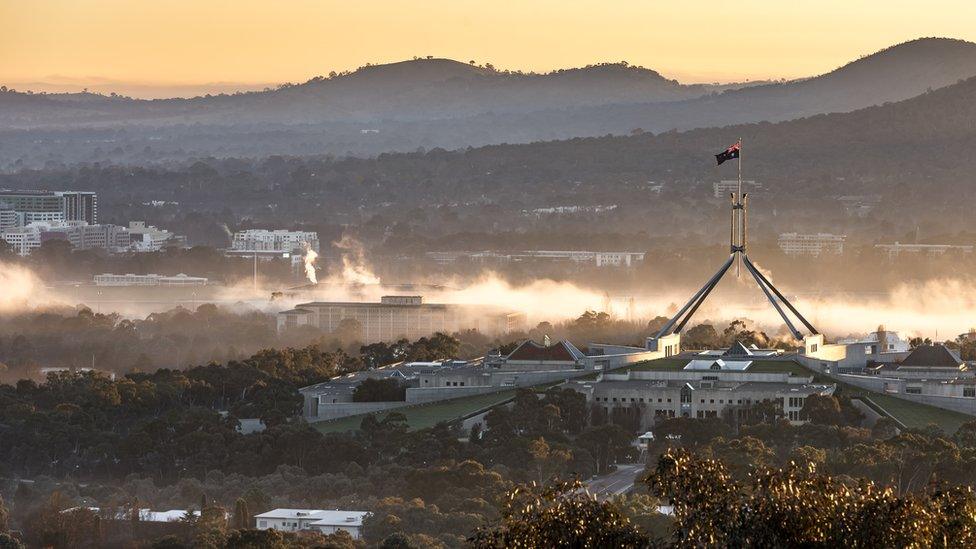The fight over the right to name Australian places
- Published

Uluru was formerly known as Ayers Rock
When should a public place be renamed? The debate is often complex. In Australia, many would like to see names reflect a more modern, equal nation. Gary Nunn reports from Sydney.
In November last year, 30,000 Australians gathered biting their nails in Sydney's Prince Alfred Park, all watching a giant widescreen. Tension was in the air and an eerie silence preceded the din of triumphant celebrations, along with some tears of palpable relief.
It was the chosen venue of the Yes campaign to marriage equality to gather for the result of a national vote on same-sex marriage (the law went on to be changed by parliament).
Earlier this month, Sydney's city council unanimously accepted a proposal to rename the lawn where this gathering took place Equality Green.
It'll be an enduring reminder of how meaningful this space now is for LGBTQI Australians.
'Hurtful' names
It's the second recent move to rename places with the aim, say advocates, of reflecting a more contemporary Australia, at ease with both its roots and future.
Australian Capital Territory (ACT) politician Bec Cody wants to rename parts of Canberra, writing last month that some "are named after bad people, and are hurtful to the victims". She said she had received letters from constituents who had expressed pain about current names.
She tells the BBC: "At the time some places in Canberra were named, not all the facts about some people were known and community attitudes towards some behaviour was very different than today."

Canberra was chosen as the site for Australia's capital in 1908
Ms Cody says that the most common feedback has related to places named after people accused of crimes, persecuting indigenous Australians, and controversial actions during war.
Those figures include Sir William Slim, a former governor-general accused of molesting boys in the 1950s, and former Western Australia Governor James Stirling, alleged to have led a massacre in 1834.
But the co-chair of the ACT Place Names Committee, Jeff Brown, has reacted cautiously to Ms Cody's calls for a review, stating that changing names is a "very awkward and confusing thing", because it'd require thousands of people to change their personal contact details, and require updates to electronic maps and records.
"The usual principle is place names are enduring," he said.
Renaming: rare but possible
However, it has been done. Australia's Northern Territory (NT), which has the highest Aboriginal population, features the most famous renaming.
Ayers Rock was renamed Uluru in 1993, becoming the territory's first official dual-named place, switching its colonial namesake (former South Australian Premier Sir Henry Ayers) to the language of its traditional owners, the Anangu people: Ayers Rock/Uluru.
In 2002, that dual name was officially reversed, making it Uluru/Ayers Rock. Almost all Australians now refer to it as Uluru.
On the same day, the nearby rock formation named the Olgas by European explorer Ernest Giles in 1872 was renamed to prioritise its indigenous name, Kata Tjuṯa/Mount Olga.
There are also calls to rename Queensland's North Stradbroke Island, named after British explorers, to its indigenous Australian name of Minjerribah (meaning Island in the Sun in the local Jandai language).
The change would reflect 20,000 years of connection to this land by the Quandamooka people, the traditional owners, supporters say.
'Nomenclature matters'
Former NT Attorney General John Elferink held the seat that included Uluru.
"Having represented an 80% Aboriginal electorate for eight years, I can tell you nomenclature does matter," he says, stating that renaming remote communities back to their traditional languages allows people "to assert themselves in their own country".
Two examples he remembers are the community of Hermannsberg being renamed Ntaria and Santa Teresa being renamed Ltyentye Apurte.
"The idea of naming things after Aboriginal language groups isn't anything new," Mr Elferink says.

You might also be interested in:

How do we know where to start and stop?
Every street name in the Darwin suburb of Muirhead is named after one of 40 major Aboriginal language groups.
But it creates challenges, Mr Elferink says: "The intent was honourable, but the names were created by linguists and there's nothing more incomprehensible than a linguists' interpretation of someone else's language. You end up with unpronounceable street names."
There are practical reasons this may not work: "You have to spell the street carefully and slowly over phone. In case of a medical emergency, there's nothing more frustrating than if the pronunciation doesn't reflect the spelling.
"Slightly anglicised Aboriginal place names are usable across cultural boundaries."
A shared journey
Kado Muir is an anthropologist and archaeologist specialising in Aboriginal heritage and native title.
He points out that "renaming" is a misnomer: "It's actually recognising the original names of places.

Kado Muir says names play a role in reflecting Australia's maturity
"It reflects a maturity in the development of Australia to move beyond a colonial state of oppressing the First Nations peoples towards recognising and celebrating the culture of first Australians. Joint naming reflects a shared journey, acknowledging the original custodians of the land."
And finally...
There's maturing, then there's, what some may argue, is party pooping.
In 2013, the Geographical Names Board of New South Wales proposed a policy whereby confusing, hard to pronounce or likely to offend names were replaced.
It meant the state kissed goodbye to the Flannel Flower Fairway, Curly Dick Road and Titswobble Road - for altogether more pedestrian alternatives.